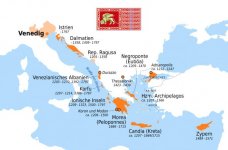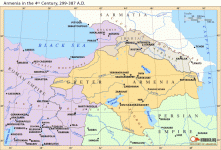Taranis
Elite member
Very nice work, Sparkey. Well done. This is indeed a very unusual pattern not found in any other Haplogroup. I also agree about the interpretation that it may represent an ancient (or at least fairly old) backmigration.
Follow along with the video below to see how to install our site as a web app on your home screen.

Note: This feature currently requires accessing the site using the built-in Safari browser.
Very nice work, Sparkey. Well done. This is indeed a very unusual pattern not found in any other Haplogroup. I also agree about the interpretation that it may represent an ancient (or at least fairly old) backmigration.
Nordtvedt places the cluster that extends eastward as being quite a lot younger than I2c as a whole, something like 2000-2500 years old, so I'd call it a backmigration, but not an exceptionally old one. Any ideas? It seems that they were seafaring and got integrated a little into some Balkan cultures (but not Albanians, at least none found so far), Greeks and Cretans especially, Caucasians like Armenians and Georgians, and Eastern European Jews. And the origin (although not necessarily the beginning of the seafaring expansion) seems to be in or around Germany. Who fits all that is beyond me. It's probably the result of multiple migrations of different groups who all had it as a minority clade, and so it doesn't reflect a particular group well. I should also note that we need more diversity data for Greek and Balkan I2c, it may be only apparently low in diversity due to the lack of STR data from those regions in particular.
This is indeed quite unusual and unexpected, and the approximate date of 2000-2500 years ago is very confusing indeed.
One idea I had for Anatolia would be the Galatians, which would fit in that time frame and also approximate homeland, but they do in NO WAY explain the vast extend this marker apparently has in Anatolia (I would expect only around Central Anatolia in such a scenario), and it is also unlikely that the small numbers of Galatians would have been responsible for this. Likewise, there is no way this could explain the concentrations (and patterns) in the Caucasus and on the Balkans!
I agree that it is probably more likely we may look at multiple migrations here.
Would it help your analysis to know that the known Anatolian I2c is dominantly from ethnic Armenians?
Hi Sparkey!
would you be so nice to explain criteria how you selected parts settled with Serbs from Bosnia mentioned in Battaglia's work?
I've took a look on the data sheets and couldn't find any geographical definition there.
I couldn't find any geographical data, either, so I just referenced a map that specifies ethnic groups by percentage, put "1-5%" in the places where Serbs are, and "trace" elsewhere.
I think that the "trace" field in Southeastern Europe will expand once we get more data from there.
Would it help your analysis to know that the known Anatolian I2c is dominantly from ethnic Armenians?

With that in mind, take a look at the map of territory controlled by the Venetian Republic at its greatest extent:
View attachment 5182
There is uncanny overlap between it and the Mediterranean portion of the I2c map.
Wow, I would have never guessed the Venetians, but that map alone basically convinces me of their importance, at least for the Balkan and Greek carriers. Probably the only reason we haven't found any I2c in modern Venice yet is due to a lack of samples, but it would make sense, because we're getting closer to the center of diversity of I2c with Venice.
One area of concentration in the I2c map which can't easily be accounted for by the presence of Armenians in trading colonies is Macedonia. However there is also this:
"The long-winding military conflict between the Roman and its successor Byzantine Empire and Persia culminated, in 387 AD, with the loss of the Armenian statehood as Armenia was for the first time in its history divided between those two states. The date can be conditionally set as the beginning of the Armenian Diaspora...
.....The Byzantine policy of displacing the indigenous Armenian population was of more consistent nature: for several centuries the Armenians were forced to relocate to the western regions of the Empire, including the Balkan regions of Thrace and Macedonia . The emigration of the Armenian nobility and military elite resulted in their diffusion into the highest ranks of the Byzantine government system, culminating in the establishment of the Macedonian or Armenian imperial dynasty (867-1057). "
http://www.armeniaemb.org/DiscoverArmenia/Diaspora/HistoryofDiaspora.htm
Are you talking about the original Armenian homeland near the taurus mountains ( basically modern turkey and syrian border areas ) to the caucausus area or ?.
I assume you mean that this emigration of Armenian nobility into Thrace and Macedonian was to give the Bulgars a monarcy.
Something like modern french nobility of Savoy to become kings of Italy or bavarian nobility to become kings of greece.

You need to also have a map of the Genoese holdings which dominated the black sea area.
BTW , in december 2010, the study on venetian DNA was given up due to the fact that it was too cosmoplitan in its 1100 year history, focus by DNA tests is now on the veneto mainland which I suspect will find basically ligurian, gallic and celtic markers.
KN , stated in June 2011 that the only I marker in Venice was the same as the basque and sardinian one. he basically stated this marker was an "anti R1a" marker.
If this is the case then where or how does I2c come into it.
lastly, Byzantine, Genoese and Venetian merchants practised "white" slavery from Azov , from about 600 AD until the early middle ages. This can have an effect on certian markers in certain areas
this is the last I found ( although I have not been looking anymore)
http://venice2point0.blogspot.com/2010/07/venetian-dna.html
History witnesses that Hellenistic Crete Island has for centuries been a hospitable for Armenians place. First mentioning about Armenians in the island dates back to 8-th century. Byzantium’s Nikiporos II Pakos emperor, highly evaluating the contribution of many Armenian soldiers and army commanders in the job of liberating Crete from Arab’s yoke (823-961 AD), allowed many Armenians to stay and live in the island. Already in 970’s the number of Armenians here reached 20,000, and Greek sources give a number of 16,000. After the collapse of Cilicia Armenian kingdom in 1375 AD a new flow of Armenian refugees started to Crete. The existence of villages with Armenian names like Armenis, Armenokhorio, Armenoi witness about it.
Great job, thanks Sparkey!
"9% among Georgians per 23andMe" - that's probably just me
As for the I2c in the Caucasus/Anatolia I strongly believe that they came with Phrigians/Meskhi from Balkans about 3000+ years ago. Historical sources verify that 2800 years ago they entered the territory of modern Georgia and established their capital city at Mtskheta (in Georgian the name means 'belonging to Meskhi). In Anatolia their main city was Mazaka (same Meskhi root) later Cesaria of Byzantium.
As for many I2c among modern ethnic Armenians, mostly they are from the historic Meskhi territories which were changing hands between Georgian, Armenian, Iranian and later Turkish realms.
This thread has been viewed 116601 times.
